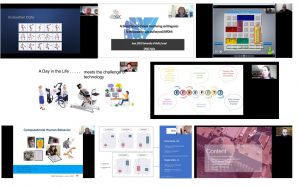Data Science Research Center’s (DSRC) monthly research Colloquium.
The Synergy Between Data Science and environmental science
14:00-14:40: Data Science of the Natural Environment: Opportunities and Challenges?
Prof. Gordon Blair (School of Computing & Communications, University of Lancaster)
Data science is the science of extracting meaning from potentially complex data. This is a fast moving field, drawing principles and techniques from a number of different disciplinary areas including computer science, statistics and complexity science. Data science is having a profound impact on a number of areas including commerce, health and smart cities. This will argue that data science can have an equal if not greater impact in the area of earth and environmental sciences, offering a rich tapestry of new techniques to support both a deeper understanding of the natural environment in all its complexities, as well as the development of well-founded mitigation and adaptation strategies in the face of climate change. In the talk, I will argue that data science for the natural environment brings about new challenges for data science, particularly around complexity, spatial and temporal reasoning, and managing uncertainty. I will conclude with a research roadmap highlighting ten top challenges of environmental data science and also an invitation to become part of an international community working collaboratively on these problems.
14:40-14:55: Questions
14:55-15:20: Harnessing eco-informatics to improve our understanding of ecological patterns and processes
Dr. Avi Bar-Massada (Department of Biology & Environment, University of Haifa)
Ecology strives to understand the interactions among species and their abiotic environment. A fundamental ecological question is what drives the geographic distribution of species, and to what extent these distributions are affected by biotic interactions and the abiotic environment. These questions are typically answered using species distribution models, which require large amounts of data on species occurrence locations as well as the environmental conditions in them. Such data requirements raise several challenges related to data acquisition and data analysis. Specifically, how can we improve data acquisition and data quality, and how can we analyze ever-increasing amounts of data without losing sight of the basic ecological principles that govern distribution patterns. These challenges are central to the emerging field of eco-informatics. In this presentation I will outline these issues, and exemplify, using three studies, the potential of data-science methods to enhance data collection, data analysis, and the ecological insights we derive from data. The first study deals with the automated classification of species occurrence in sites from data collected in the field. The second study presents a method to improve the predictive accuracy of species distribution models by the incorporation of data on multiple species at once. Finally, the third study reveals how environmental gradients drive species co-occurrence patterns across broad spatial extents. Together, these three examples highlight the potential of collecting and utilizing large ecological datasets in order to better understand ecological patterns and processes in a changing world.
15:20-15:27: Questions
15:27-15:53: GIScience integrated with computer vision for spatial examination of old visual sources
Dr. Motti Zohar (Department of Geography & Environmental Studies, University of Haifa)
Landscape reconstructions and deep maps are two major approaches in cultural heritage studies. In general, they require the use of historical visual sources such as maps, graphic artworks, and photographs presenting areal scenes and views, from which one can extract important spatial information. However, photographs, the most accurate and reliable source for scenery reconstruction, are available only from the second half of the 19th century onward. Thus, for earlier periods one can rely only on old artworks. Nevertheless, the accuracy and inclusiveness of old artworks are often questionable and must be verified carefully. In this talk, the use of GIScience methods with computer-vision capabilities to interrogate old engravings and drawings is presented. The developed approach is demonstrated using old depictions of Jerusalem that were created between the 17th and 19th centuries.
15:53-16:00 Questions
_______


